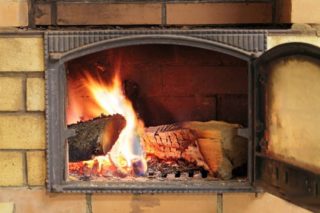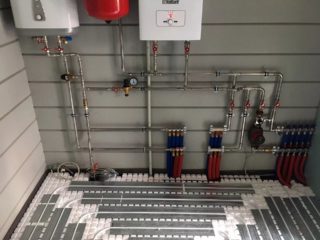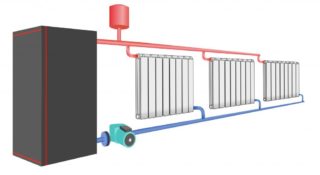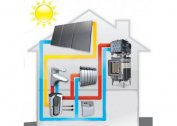More and more often, residents of large megalopolises, wound up by urban life, come to the idea of buying a house in the country or buying a plot for its construction. However, the townspeople, who are accustomed to comfort in everyday life issues, are trying to provide themselves with all the benefits of civilization - to bring water into the house, to build without fail an economic unit with a shower, a warm toilet and the like. However, this will not please anything if the house is cold in the winter. Therefore, the most important issue for a comfortable stay, of course, is a reliably equipped home heating. It is about which heating system will best solve this issue, and we will talk in this article. And we will begin, of course, with a review of heating systems available to the mass consumer.
Types of heating systems
Today, there are several main types of heating systems used for heating homes:
- Stove heating.
- Electric heating.
- Water heating.
- "Warm floor".
Furnace Heating
 The first type of heating, stove - is the most common for residents not only of villages, but also of many townspeople, because it is no secret that not all cities still have central heating and many people living in fairly large cities drown in the old fashioned way - with firewood. If the house in the village was inherited from the grandmother, then most likely it will be heated in this way. Stove heating, of course, is quite troublesome, since firewood today is not only an expensive pleasure, but also time-consuming to reach the required temperature in the house. In addition, for working people, coming to an unheated, cold house and then messing around with kindling, waiting until it becomes warm in the house is not very convenient. Therefore, this type of heating is only good as an extra - in the form of a fireplace, for example. Romance with a kindled fireplace and live fire is good for those who have a lot of time, and there is a fairly reliable alternative heat source, while powerful and at the same time economical.
The first type of heating, stove - is the most common for residents not only of villages, but also of many townspeople, because it is no secret that not all cities still have central heating and many people living in fairly large cities drown in the old fashioned way - with firewood. If the house in the village was inherited from the grandmother, then most likely it will be heated in this way. Stove heating, of course, is quite troublesome, since firewood today is not only an expensive pleasure, but also time-consuming to reach the required temperature in the house. In addition, for working people, coming to an unheated, cold house and then messing around with kindling, waiting until it becomes warm in the house is not very convenient. Therefore, this type of heating is only good as an extra - in the form of a fireplace, for example. Romance with a kindled fireplace and live fire is good for those who have a lot of time, and there is a fairly reliable alternative heat source, while powerful and at the same time economical.
Electric heating
 Powerful and economical - such a source can be heating with electricity. There are many modifications of electrical appliances designed to heat fairly large living spaces. There are many advantages to choosing this type of heating. First: electricity is the absence of open fire, as everyone knows, it is open fire that is the source of all fire hazard situations. Secondly, there is no need to expend a lot of effort for laying all kinds of pipes and other communications, such as, for example, for arranging water heating. Laying cables does not take too much time, effort or money. Electric heating is a dry and warm house, and when installing automation, it also does not require a human presence. That is, having set the program to constantly maintain a certain temperature, you don’t have to worry about coming home from work, you will need to take care of how to warm up faster. However, there are also some disadvantages to consider. Since the winters in our country are quite long, snowy and windy, emergency outages often occur and the house may be left without heat. Therefore, to avoid this, the owners have to have an emergency power plant - a generator. And a generator means high fuel costs with a relatively small return. It can be concluded that this type of house heating is suitable for relatively small, one-story houses.
Powerful and economical - such a source can be heating with electricity. There are many modifications of electrical appliances designed to heat fairly large living spaces. There are many advantages to choosing this type of heating. First: electricity is the absence of open fire, as everyone knows, it is open fire that is the source of all fire hazard situations. Secondly, there is no need to expend a lot of effort for laying all kinds of pipes and other communications, such as, for example, for arranging water heating. Laying cables does not take too much time, effort or money. Electric heating is a dry and warm house, and when installing automation, it also does not require a human presence. That is, having set the program to constantly maintain a certain temperature, you don’t have to worry about coming home from work, you will need to take care of how to warm up faster. However, there are also some disadvantages to consider. Since the winters in our country are quite long, snowy and windy, emergency outages often occur and the house may be left without heat. Therefore, to avoid this, the owners have to have an emergency power plant - a generator. And a generator means high fuel costs with a relatively small return. It can be concluded that this type of house heating is suitable for relatively small, one-story houses.
Water heating
 If the country house is quite impressive in size, or has more than one floor, then it makes sense to attend to the installation of a water heating system, which can solve many problems in this area. Such a system assumes the presence of a rather bulky and extensive network of pipes, the laying of which is a rather serious undertaking and therefore only good specialists in their field can competently implement it. Heat is supplied using special installations, the heat carrier is water, which circulates through pipes, gives off heat and heats the air in the room. To install the boiler, you must have a separately built, or attached to the house building - a boiler room. Here you can store fuel, if it is, say, firewood or other solid fuel. If there is gas supply, then the room must also have a special ventilation system provided for by the norms of gas services. Water heating is the most popular type of heating for country houses and, despite its high cost during installation and further maintenance, is a fairly reliable option. The only minus is the possibility of its failure in the event of freezing water in the pipes, but these are very rare cases and good owners almost never happen.
If the country house is quite impressive in size, or has more than one floor, then it makes sense to attend to the installation of a water heating system, which can solve many problems in this area. Such a system assumes the presence of a rather bulky and extensive network of pipes, the laying of which is a rather serious undertaking and therefore only good specialists in their field can competently implement it. Heat is supplied using special installations, the heat carrier is water, which circulates through pipes, gives off heat and heats the air in the room. To install the boiler, you must have a separately built, or attached to the house building - a boiler room. Here you can store fuel, if it is, say, firewood or other solid fuel. If there is gas supply, then the room must also have a special ventilation system provided for by the norms of gas services. Water heating is the most popular type of heating for country houses and, despite its high cost during installation and further maintenance, is a fairly reliable option. The only minus is the possibility of its failure in the event of freezing water in the pipes, but these are very rare cases and good owners almost never happen.
Underfloor heating
 Along with these fairly traditional methods of heating, a heating system called the “underfloor heating” is becoming increasingly popular. This method of heating the room is quite convenient, and most importantly - very useful. All heating elements are hidden under the floor and do not collect dust on their surfaces, which means that an extra factor in the occurrence of allergies in households is not created. Heating of air in the room occurs from below, by heating the entire floor surface. As you know, if a person’s legs are warm, then the whole body does not feel cold, so there is no need to bring the temperature in the room to high values, the air will not dry out and retain its natural humidity, which has a very positive effect on the person’s breathing system. If you lay pipes made of ultra-modern structured polyethylene under the floor, such a system will be more than reliable. For families with young children who love to play on the floor, the floor heating system is the most ideal option.
Along with these fairly traditional methods of heating, a heating system called the “underfloor heating” is becoming increasingly popular. This method of heating the room is quite convenient, and most importantly - very useful. All heating elements are hidden under the floor and do not collect dust on their surfaces, which means that an extra factor in the occurrence of allergies in households is not created. Heating of air in the room occurs from below, by heating the entire floor surface. As you know, if a person’s legs are warm, then the whole body does not feel cold, so there is no need to bring the temperature in the room to high values, the air will not dry out and retain its natural humidity, which has a very positive effect on the person’s breathing system. If you lay pipes made of ultra-modern structured polyethylene under the floor, such a system will be more than reliable. For families with young children who love to play on the floor, the floor heating system is the most ideal option.
Thus, we see that all four considered heating systems have both pros and cons, and can be used quite effectively depending on certain conditions.


